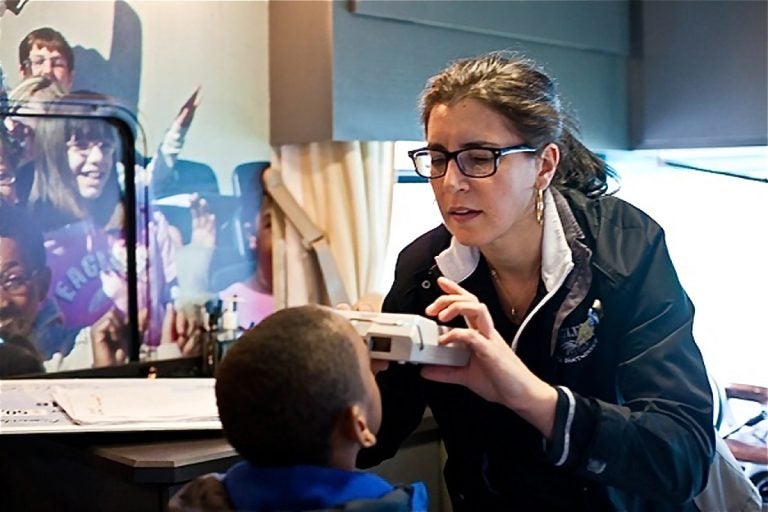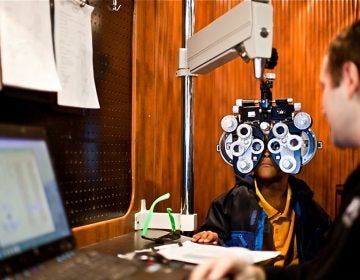Look out for ‘lazy eye,’ a vision problem that worsens as children get older
Amblyopia affects three out of every 100 kids. Age 2 is the ideal time to detect and treat it, vision experts say, but that doesn’t happen often.

Three children in 100 have amblyopia or “lazy eye,” a vision-robbing, brain-connected disorder that typically affects just one eye. (Brad Larrison for WHYY)
How do we help children thrive and stay healthy in today’s world? Check out our Modern Kids series for more stories.
She’s an active little girl, a 2-year-old eager to toss a ball, whoosh down a slide, dig in the sand. If she’s still, it’s because she’s sleeping. If she’s quiet, it’s because she’s chewing.
If her throw seems a bit off, or she fumbles a step on an uneven sidewalk or maybe gets less sand in her bucket than she gets on herself — well, she’s only 2. Why mention it to the pediatrician?
Here’s one reason: The chances are good a 2-year-old isn’t going to tell her parents that the vision in one of her eyes is blurry, or that she can see better if she tilts her head. For her, it’s the normal way she sees.
An eye doctor, on the other hand, might notice something not so normal: When the toddler looks at something, her eyes don’t stay focused. Or that maybe one eye looks slightly out of sync with the other.
Three children in 100 have amblyopia or “lazy eye,” a vision-robbing, brain-connected disorder that typically affects just one eye. Age 2 is the perfect time for amblyopia to be detected, diagnosed, and treated quickly, vision experts say.
Yet the experts note that it’s far more likely none of that will happen for another two or three years. And by then, they say, it might be too late to totally reverse the brain’s reaction to recognizing only the visual input from one eye. With amblyopia, speed is truly of the essence.
“I had a kid [recently] at age 11,” said David G. Hunter, ophthalmologist in chief at Boston Children’s Hospital. “No one had ever figured out he couldn’t see. … He had never been effectively screened. No one had ever gotten him to cover up each eye” so vision in each could be tested.
Amblyopia is considered a brain-pathway issue, not an eye problem, and it worsens with time. As the child’s brain develops, that eye’s neural pathway, never properly used, will harden. The older the child gets, and the longer he goes without treatment, the more difficult correcting the damage becomes.
Children aren’t born with amblyopia, but rather with conditions that lead to it: a cataract; an eye-muscle abnormality; uneven focus between the two eyes.
Early detection paramount
So where’s the problem? Diagnose the child at an early age, treat the amblyopia with a patch or a pair of prescription glasses, and the vision problem disappears.
If only it were that simple. Besides trying to get a squirmy toddler to sit for an eye test, a health care practitioner must want to diagnose a 2-year-old. Experts say these kids should be tested, but two years ago a U.S. task force said not enough evidence existed to warrant it before the recommended age of 3.
That same year, though, a survey of 12 practices showed just 39% of 3-year-olds were tested for amblyopia, compared with 83% of 5-year-olds.
And then, once diagnosed, the child and the parents have to follow the doctor’s instructions about treatment.
“I see them coming in at 5, 6, 7, and now it’s too late for full treatment,” said Hunter, who is also a professor of ophthalmology at Harvard Medical School.
Some children would not wear their eye patches, or some other prescription was ignored, he said, adding, “It is really hard to check vision in kids.”
Amblyopia is an odd duck of a disorder. Though it’s attributed to faulty brain processing, the normal treatment – an eye patch usually followed by eyeglasses — is done through sensory stimulation, said Michael X. Repka, of the Wilmer Eye Institute at Johns Hopkins.
Eye conditions in newborns that can lead to amblyopia include strabismus, in which the eye muscles are not balanced, and refractive anisometropia, a difference in the two eyes’ visual acuity that is so severe the brain eventually ignores the weaker eye.
Stanley Hatch, an optometrist at Salus University in Elkins Park, said amblyopia is caused by an equal split between the two problems. Farsightedness, too, can lead to strabismus, which can lead to amblyopia.
Earlier detection gives a child the best chance for great sight, according to Repka. But Hunter noted that half of all children with amblyopia are missed by age 5.
Seeking more data
As any parent knows, by the time she is 5, a child can say no and mean it. A 5-year-old will remove glasses or yank off a patch. An older child won’t want to be laughed at in school because of them. But one U.K. study showed that among other factors getting in the way of treatment for amblyopia were parents’ understanding of the condition’s severity and even the logistics of getting a child to the doctor. It cited, for instance, a parent who missed eye appointments for her child because she couldn’t find parking.
Optometrists and ophthalmologists, including Hatch, Hunter and Repka, are working on ways to help these kids keep as much sight as they can. Hatch and longtime U.K. researcher Irene Gottlob, working independently, want better information on existing treatments.
“There are no hard data,” said Gottlob, a professor in the Department of Neuroscience, Psychology and Behavior at the University of Leicester in England. “That is the reason there are more studies.”
Hunter has traveled his own road with blinq, an instrument developed over decades and intended as a detection device for the masses.
“It’s frustrating, seeing kids come into the office at 5, 6 years old, knowing their vision will be difficult to recover,” Hunter said. Let alone knowing the problem could have been taken care of earlier.
“That is why I am working on this,” he said.
WHYY is your source for fact-based, in-depth journalism and information. As a nonprofit organization, we rely on financial support from readers like you. Please give today.






